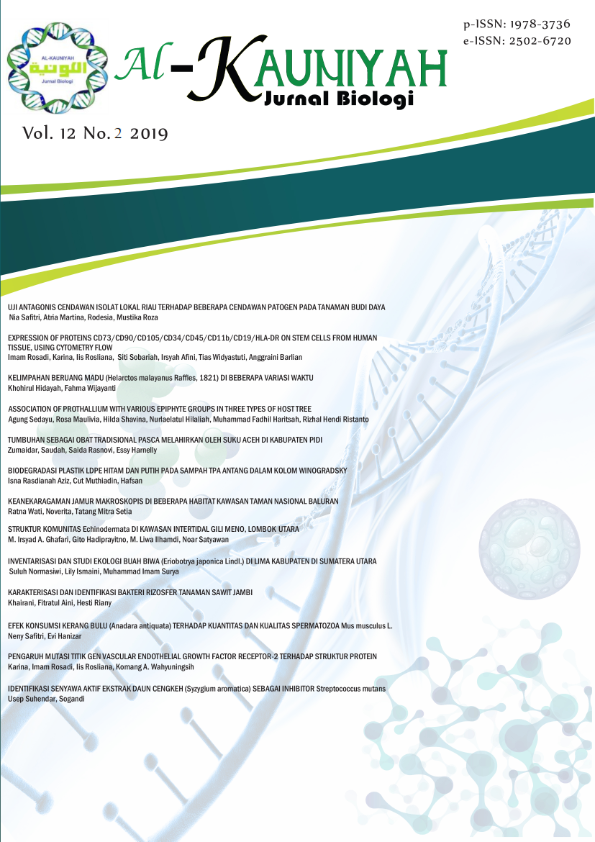BIODEGRADASI PLASTIK LDPE HITAM DAN PUTIH PADA SAMPAH TPA ANTANG DALAM KOLOM WINOGRADSKY
DOI:
https://doi.org/10.15408/kauniyah.v12i2.10037Keywords:
Biodegradasi, Plastik, Sampah, TPA Antang, Winogradsky, Antang landfill, Biodegradation, Garbage, PlasticAbstract
Abstrak
Dalam dunia industri, baik industri sandang, pangan, papan, transportasi, medis maupun rekreasi tidak terlepas dari penggunaan kantong plastik. Karena bersifat praktis, berbagai jenis kantong plastik sebagai kemasan selalu menjadi pilihan dalam aktivitas masyarakat. Akan tetapi, sifat plastik yang sulit terdegradasi pada lingkungan alami menimbulkan permasalahan sebagai salah satu sumber pencemaran. Penelitian ini bertujuan untuk mengetahui potensi mikroorganisme tanah yang diisolasi dari sampah Tempat Pembuangan Akhir (TPA) Antang Makassar dalam mendegradasi kantong plastik LDPE hitam dan putih. Metode biodegradasi plastik yang digunakan adalah kolom Winogradsky dengan menggunakan kolom kaca 1.000 mL yang berisi 500 gram tanah sampah TPA Antang dan plastik uji LDPE warna hitam dan putih. Kemudian dilakukan pengukuran persentase degradasi selama 3 bulan masa inkubasi dengan waktu panen selama 3 minggu sekali. Hasil penelitian menunjukkan bahwa terdapat 6 isolat dalam kolom Winogradsky mampu mendegradasi plastik LDPE hitam sebesar 3,5% dan 6 isolat lainnya mampu mendegradasi plastik LDPE putih sebesar 2%. Selanjutnya, isolat ini dapat digunakan sebagai agen biodegradasi plastik di TPA Antang Makassar.
Abstract
The use of plastic bags is almost unavoidable in industries, including the food, clothing, transportation, construction, medical, and recreational industries. Various types of plastic bags have been used in various types of packaging, because of the value of practicality. However, the difficulties in the degradation process become a problem as a pollution source in the environment. The purpose of this study was to determine the potential of soil microbes isolated in Antang landfill, Makassar, in degrading black and white plastics of LDPE. The biodegradation method used was the Winogradsky column using a 1,000 mL glass column containing 500 grams of Antang landfill soil and using black and white LDPE as well. The percentage of degradation was measured for three months incubation period with harvest time for three weeks. The results showed that the inoculum in Winogradsky column was able to degrade the black plastic by 3.5% and the white plastic by 2%. The results of macroscopic and microscopic characterization showed that six isolates were degrading the black plastic and six isolates were degrading the white plastic, with different characteristics. Furthermore, this isolate can be utilized as a biodegradation agent for plastic in the Antang landfill.
References
Ainiyah, D. N., & Shovitri, M. (2014). bakteri tanah sampah pendegradasi plastik dalam kolom winogradsky. Jurnal Sains Dan Seni Pomits, 3(2), E63-E66.
BPOM. (2017). Kemasan pangan plastik. InfoPOM, 18(3), 1-13.
Demirbas, A. (2011). Waste management, waste resource facilities and waste conversion processes. Energy Conversion and Management, 52(2), 1280-1287. doi: 10.1016/j.enconman.2010.09.025
Donlan, R. M. (2002). Biofilms: microbial life on surfaces. Emerging Infectious Diseases, 8(9), 881-890. doi: 10.3201/eid0809.020063
Esteban, D. J., Hysa, B., & Bartow-McKenney, C. (2015). Temporal and spatial distribution of the microbial community of winogradsky columns. PLoS ONE, 10(8), 1-21. doi: 10.1371/journal.pone.0134588
Fan, Z. J., Williams, M. C., & Choi, P. (2001). A molecular dynamics study of the effects of branching characteristics of LDPE on its miscibility with HDPE. Polymer, 43(4), 1497-1502. doi: 10.1016/S0032-3861(01)00730-3
Gajendiran, A., Krishnamoorthy, S., & Abraham, J. (2016). Microbial degradation of low-density polyethylene (LDPE) by Aspergillus clavatus strain JASK1 isolated from landfill soil. 3 Biotech, 6(1), 1-6. doi: 10.1007/s13205-016-0394-x
Gross, M. (2013). Plastic waste is all at sea. Current Biology, 23(4), R135-R137. doi: 10.1016/j.cub.2013.01.070
Gross, R. A., & Kalra, B. (2002). Biodegradable polymers for the environment. Science, 297(5582), 803-807. doi: 10.1126/science.297.5582.803
Gupta, A. P., Kumar, V., & Sharma, M. (2010). Formulation and characterization of biodegradable packaging film derived from potato starch & LDPE grafted with maleic anhydride-LDPE composition. Journal of Polymers and the Environment, 18(4), 484-491. doi: 10.1007/s10924-010-0213-0
Hadad, D., Geresh, S., & Sivan, A. (2005). Biodegradation of polyethylene by the thermophilic bacterium Brevibacillus borstelensis. Journal of Applied Microbiology, 98(5), 1093-1100. doi: 10.1111/j.1365-2672.2005.02553.x
Harse, G. A. (2011). Plastic, the great pacific garbage patch, and international misfires at a cure. Journal of Environmental Law and Policy, 29(2), 331-363.
Hidayati, N. A., Aziz, I. R., Muthiadin, C. (2017, November 10). Pemanfaatan limbah plastik sebagai alternatif bahan bakar terbarukan. Paper presented at the Prosiding Seminar Biologi for Life, Gowa, Sulawesi Selatan, Indonesia. Retrieved from http://journal.uin-alauddin.ac.id/index.php/psb/article/view/4730
INAPLAS. (2017). Inaplas: kebijakan cukai plastik berpotensi matikan industri. Jakarta: Asosiasi Industri Olefin, Aromatik, dan Plastik Indonesia. Retrieved from http://inaplas.net/index.php/home/news
KEMENPERIN. (2013). Semester I, konsumsi plastik 1,9 juta ton. Jakarta: Kementerian Perindustrian Republik Indonesia.
Kyaw, B. M., Champakalakshmi, R., Sakharkar, M. K., Lim, C. S., & Sakharkar, K. R. (2012). Biodegradation of low density polythene (LDPE) by Pseudomonas species. Indian Journal of Microbiology, 52(3), 411-419. doi: 10.1007/s12088-012-0250-6
Parks, S. (2015). Microbial life in a winogradsky column: from lab course to diverse research experience. Journal of Microbiology and Biology Education, 16(1), 82-82.
Priyanka, N., & Archana, T. (2011). Biodegradability of polythene and plastic by the help of microorganism: a way for brighter future. Environmental and Analytical Toxicology, 1(4), 1-4. doi: 10.4172/2161-0525.1000111
Riandi, M. I., Kawuri, R., & Sudirga, S. K. (2017). Potensi bakteri Pseudomonas sp. dan Ochrobactrum sp. yang diisolasi dari berbagai sampel tanah dalam mendegradasi limbah polimer plastik berbahan dasar high density polyethylene (HDPE) dan low density polyethylene (LDPE). Jurnal Simbiosis, 5(2), 58-63. doi: 10.24843/JSIMBIOSIS.2017.v05.i02
Rochman, C. M., Browne, M. A., Halpern, B. S., Hentschel, B. T., Hoh, E., Karapanagioti, H. K., … Thompson, R. C. (2013). Policy: classify plastic waste as hazardous. Nature, 494, 169-171. doi: 10.1038/494169a
Sivan, A., Szanto, M., & Pavlov, V. (2006). Biofilm development of the polyethylene-degrading bacterium Rhodococcus ruber. Applied Microbiology and Biotechnology, 26(3), 246-265. doi: 10.1007/s00253-005-0259-4
Yaşa, İ., Çadırcı, B. H., Koçyigit, A., & Öztürk, T. (2006). Enrichment and isolation of anoxygenic phototrophic bacteria in winogradsky column. U. Journal of Fisheries & Aquatic Sciences Cilt Sayı/Issue, 23(1), 71-73.
Zusfahair, Z., Lestari, P., Ningsih, D. R., & Widyaningsih, S. (2007). Biodegradasi polietilena menggunakan bakteri dari TPA (tempat pembuangan akhir) Gunung Tugel Kabupaten Banyumas. Molekul, 2(2), 98-106. doi: 10.20884/1.jm.2007.2.2.39

